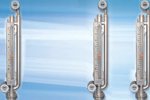

K-TEK, a leading manufacturer of state-of-the-art level instrumentation for liquid detection, manufactures the new MagWave Dual Chamber Level Measurement System. This is a lightweight, compact, precision-fabricated unit which is designed to provide independent, redundant measurements in a variety of applications in the oil, gas, petrochemical and power industries.
The system is designed around a unique, dual chamber enclosure that provides added flexibility and accuracy. Two, tightly integrated but independent chambers include a magnetic level gauge for level indication based on the specific gravity of the process, and a guided wave radar transmitter for measurements based on dielectric constant.
Unlike single chamber designs, this product can be used to measure clean or dirty fluids. A separate chamber for the guided wave radar eliminates the need for a coaxial cable and allows customers to use the system in processes that may contain particulate matter that may build up on probes. The dual chamber design also removes extra parts from within the magnetic level gauge chamber, eliminating potential float obstructions. The process connections on the MagWave are not limited to the side, but can be placed on the top, bottom, or side of the gauge. Vent and drain valves can be incorporated without changes in the chamber size, keeping the unit smaller and lighter than other approaches. If required, indicators can be repositioned from the factory-assembled locations.
"Redundancy is often required in challenging applications, such as feedwater heaters, industrial boilers, and wastewater tanks," said Robert Hotard, product manager for Radar and RF products at K-TEK. "MagWave combines the robustness of the magnetic level gauge with the accuracy of guided wave radar. In fact, the system can also combine guided wave radar, magnetostrictive, and capacitance transmitters in a single, compact unit. Add in the available switching options and the configurations for redundancy become limitless."
MagWave's magnetic gauge is based on the company's rugged, float-based KM26 Magnetic Level Gauge. A visible shuttle or bargraph indicator magnetically couples to a float through the wall of the float chamber, thus avoiding direct contact with the process fluid. This eliminates problems with coating, plating, fouling, fugitive emissions, and hazardous material leaks, as well as provides accurate readings through dirty or colourless fluids, common with standard sight glasses.
In its standard configuration, the second MagWave chamber contains the company's robust, MT2000 Guided Wave Radar Transmitter. With no moving parts there is virtually no maintenance required. A waveguide cable or rod directs the microwave pulses directly to the product surface, eliminating the beam divergence problems common to conventional non-contact radar transmitters. The incorporation of a single, wave guide antenna and the secondary MagWave chamber allows the measurement of low dielectric materials, such as propane, hexane, and butane without the need for a coaxial type probe. The instrument provides accurate level measurements even with widely varying temperatures and pressures: up to 3000 psi (20,7 MPa) or 800°F (427°C).
Each MagWave system is custom-configured for the customer's application. The second chamber can be fitted for guided wave radar, magnetostrictive, or capacitance transmitters.
The standard configuration, the C1P11 waveguide, is rated to 1500 psi at 100°F (10,3 MPa at 38°C) and a cable probe. The transmitter connection is a ¾" NPT (19 mm) thread and the cable is weighted for centring within the chamber. The standard housing is powder-coated aluminium; an optional stainless steel housing handles corrosive environments.
FM approved and CSA
Certified for use in hazardous areas, the MT2000 is also ATEX certified for use in potentially explosive atmospheres.
Also available is the C8P71, a robust coupler and waveguide created specifically for high temperature and high pressure hydrocarbon applications. The coupler can withstand extreme pressure and has the highest temperature rating in the industry: 1500 psi at 800°F (10,3 MPa at 427°C). The C8P71 has an hermetic seal and is unaffected by vapours (excluding steam), making it especially useful for noxious environments.
The C9P81 waveguide is designed specifically for saturated steam applications, such as those found in power generation plants and industrial heat processes. The C9P81 features an alumina ceramic insulator that allows accurate and reliable measurements up to 2000 psi at 635°F (13,8 MPa at 335°C).

© Technews Publishing (Pty) Ltd | All Rights Reserved